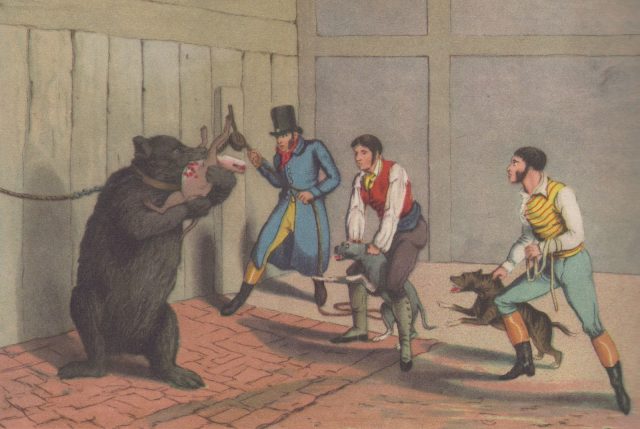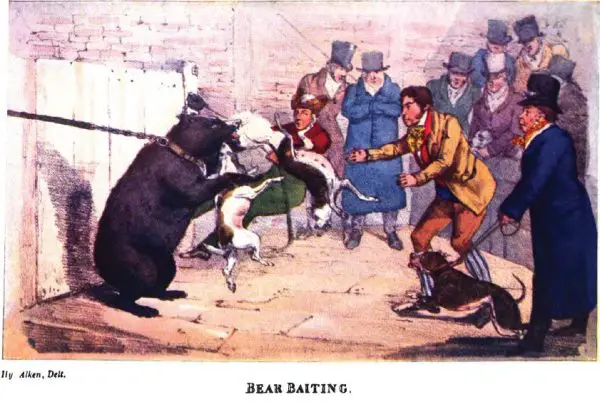Many of the traditional sports and pastimes of the Victorian era were what would now be classed as blood sports and have long since been outlawed and suppressed. From the sixteenth century, many herds of bears were maintained for baiting. In its best-known form, arenas for this purpose were called bear-gardens, consisting of a circular high fenced area, the “pit”, and raised seating for spectators.
Bear baiting game
A post would be set on the ground towards the edge of the pit and the bear chained to it, either by the leg or neck. A number of well-trained hunting dogs would then be set on it, being replaced as they tired or were wounded or killed.

In some cases the bear was let loose, allowing it to chase after animals or people. For the purpose of bull baiting, the bull was usually placed in a specially constructed ring for the purpose, and tied to an iron stake so that it could move in an area of about 30 feet.

Bull baiting sport
The object of the sport was for the dogs to immobilize the bull. Before the event started, the bull’s nose might have been blown full of pepper to enrage the animal before the baiting. The bull was often placed in a hole in the ground. A variant of bull-baiting was “pinning the bull”, where specially-trained dogs would be set upon the bull, one at a time, a successful attack resulting in the dog fastening his teeth strongly in the bull’s snout.

The baiting of animals with dogs was a very popular sport in the Victorian era, with bull-baiting being the most common and taking place at any time, but particularly popular at, fairs, elections, and other gatherings. It involved tying a bull to a permanent ring, or stake driven securely into the ground, with about fifteen feet of rope secured to the base of its horns. Dogs were then let loose, one or several at a time, and encouraged to attack or bait the bull.
Any dog could be used, but in most places, people bred and trained animals for the sports e.g.bulldogs, mastiffs, and so on. As its horns had been blunted, the bull’s main defence was to toss the dogs into the air, and the dog-owners were adept at catching them on sloping poles to break their fall. The sport was given legitimacy by the belief that beef from baited bulls was much tenderer than from normally slaughtered animals, and in some places, local regulations insisted that bulls be baited before being killed.
How did the custom of bull and bear baiting end?
A Bill for the suppression of the practice was introduced into the British House of Commons in 1802, but was defeated by 13 votes, and it was not until the year 1835 that it was finally put down by Act of Parliament, called the Cruelty to Animals Act 1835, which forbade the keeping of any house, pit, or other place for baiting or fighting any bull, bear, dog, or other animal.
The opposition to blood sports comprised only part of the drive against the leisure pursuits of the working classes in the 18th and 19th centuries.